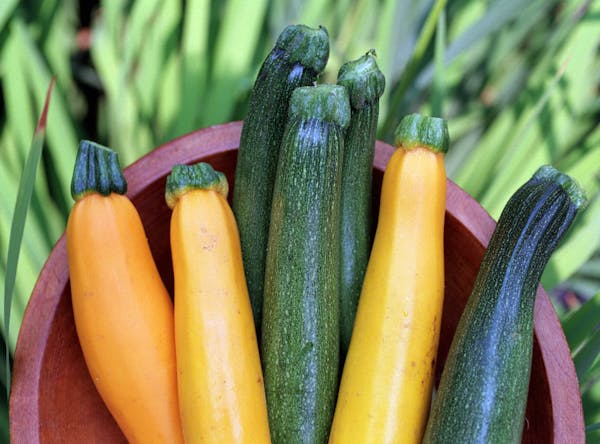The economy's down in the root cellar. Food scares have wilted our zest for store-bought spinach and drained the fun out of peanut butter. What's a worried consumer to do? Grow your own veggies. All signs point to a bumper year for vegetable gardening, and many of those buying seeds and signing up for classes this season appear to be verdant virgins making their first attempt at back-yard agriculture.
If you don't have a green thumb -- or even a clue -- here are some easy starter crops, recommended by local plant folk, that will deliver satisfactory yields with minimal effort.
TOMATOES
You can't beat the taste of a just-picked, sun-ripened tomato. And luckily, they're also one of the easiest edibles to grow. "You get so much reward from one tomato plant," said Paige Pelini, co-owner of Mother Earth Nursery in Minneapolis. For maximum yield, choose a disease-resistant hybrid tomato plant, advised Mike Hibbard, horticultural adviser for Bachman's. (His personal pick: Big Beef.) But Minneapolis garden blogger Lori Erickson, who prefers unusual varieties, says that some heirlooms, particularly smaller and yellow varieties, also can deliver satisfactory yields.
Do: Plant in the sunniest spot you've got. And wait until the ground warms up. Pelini recommends June 1, even though the last frost date is May 15. "They don't like cold topsoil, and they'll just struggle," she said. Keep plants well-watered but not soggy throughout the growing season. Tomatoes need consistent moisture.
Don't: Cramp their style, if you're going the container route. Too-small pots will diminish your returns considerably. "The bigger the container, the better the plant will do for you," Hibbard said.
CUCUMBERS
Cool, crisp cukes are a summer-salad staple. For best results, start cucumbers from seed, in the house, then plant outside in full sun once the ground warms up, Hibbard said. You also can buy seedlings at a nursery. If you're looking for a simple, basic starter cuke, he recommends the Straight 8 variety -- "it's a good slicer." This year, he's also experimenting with Hmong Red cucumbers, which bear distinctive reddish fruit with a hint of sweetness.
Do: Provide vertical support, such as a trellis. Cukes tend to sprawl. They'll take up less garden space and be easier to harvest if they're growing upward.
Don't: Overplant. Cucumbers can be big producers. "One or two plants will keep you happy all summer long," Hibbard said. A dozen plants will leave you -- and your neighbors -- sick to death of cucumbers.
SUMMER SQUASH
The prolific yellow crookneck squash -- and its even more prolific cousin zucchini -- can't be stopped once it starts growing. (Gardeners make jokes about running out of recipes long before they run out of squash.) But joking aside, they're a versatile addition to your summer table. Slice them and toss them on the grill, as part of a kebab or a side vegetable. Bake them with a little Parmesan cheese, or mash them like a potato.
Do: Be on the lookout for wilted leaves and yellowish "sawdust," which could indicate the presence of vine borers. To combat them, use beneficial nematodes (microscopic worms), sold at garden centers.
Don't: Forget to harvest frequently. The squash are much more tender and tasty when they're small. "You have to watch them every day -- they grow that fast," Hibbard said.
SWISS CHARD
Swiss what? OK, this sturdy, leafy green isn't on a lot of folks' must-eat lists. But it has many virtues as a garden crop. It's tough and hardy, tolerating poor soil, inattention, frost and even mild freezes. You can plant seeds early, as soon as April, and harvest well into the fall. And its bright and varied colorations, unusual in the vegetable world, can add visual pizazz to garden beds and borders.
Do: Make the most of its striking looks, using the vivid scarlet stems and deep-green leaves as decorative foliage. "They're beautiful," Pelini said. "A lot of people are putting them in containers with flowers." Swiss chard doesn't mind crowding, so you can cram it into pots or window boxes and still produce an edible crop.
Don't: Overlook chard's versatility as a vegetable. In addition to the leaves, which can be cooked like spinach or added raw to salads, you can also cook the stems, just as you would asparagus, and eat them as a stand-alone veggie or add them to soups and pastas.
BEETS
If you've written beets off after sampling the soggy little slabs that show up at salad bars, you're missing out. Roasted beets have an earthy yet mellow taste that's nothing like the pickled form. They're great in salads, with a few crumbles of assertive cheese, or on their own. And beets are extremely easy to grow. Once the snow is gone and the earth has thawed (hopefully by early April), Hibbard just tosses seeds onto the ground -- then ignores them. "They germinate with no care at all," he said.
Do: Harvest beets when they reach about 1 inch in diameter, approximately mid-July.
Don't: Forget about the edible greens, which can be harvested throughout the summer. (Try sautéing them like spinach, with a little bacon and chopped onion.)

Minnesota Sports Hall of Fame: A class-by-class list of all members

This retired journalist changed professional wrestling from Mankato

